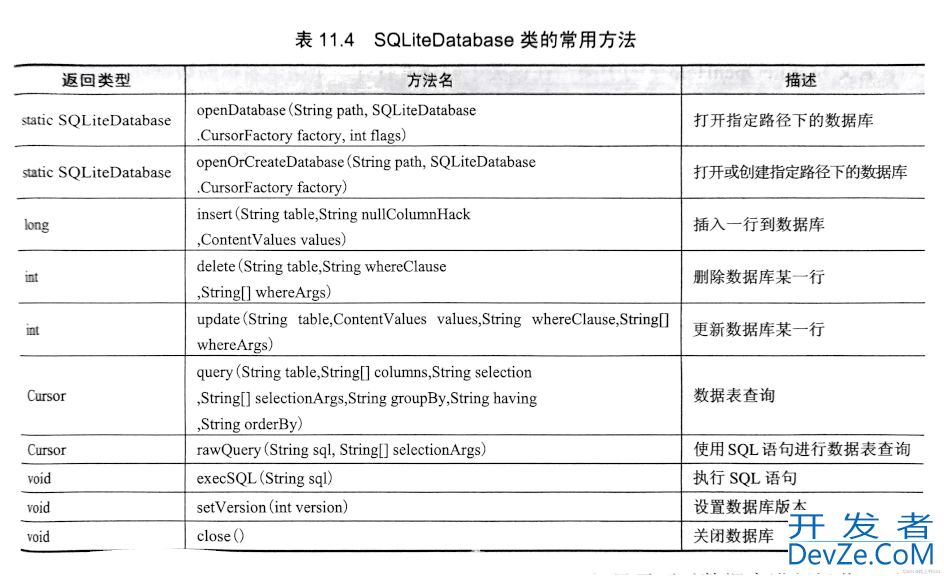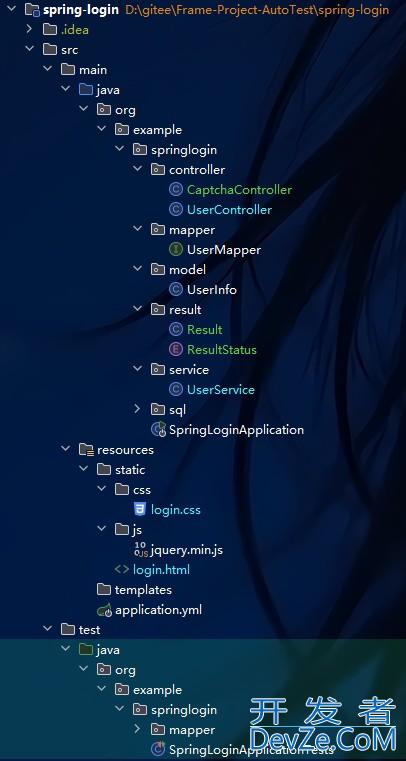Kotlin数据存储方式全面总结讲解
目录
- 1、文件存储
- 2、SharedPreferences存储
- 将数据存储到编程客栈SharedPreferences中
- 从sharedpreferences中读取数据
- 3、SQLite数据库存储
- 创建数据库
- 升级数据库
- 添加数据
- 更新数据
- 删除数据
- 查询数据
- 4、使用SQL操作数据库
1、文件存储
文件存储是android中最基本的数据存储方式,它不对存储的内容进行任何格式化处理,有数据都是原封不动地保存在文件当中的,因此它比较适合存储一些简单的文本数据或者二进制数据。
(1)将数据存储在文件中
Context类中提供了一个openFileOutput()方法,用于将数据存储到指定的文件中。
第一个参数:文件名(系统会自动创建这个文件)。
第二个参数:文件的操作模式。
文件的操作模式有以下几种:
- Context.MODE_PRIVATE:私有覆盖模式。只能被当前应用访问,并且如果写入,则覆盖。
- Context.MODE_APPEND:私有追加模式。只能被当前应用访问,并且如果写入,则追加。
- Context.MODE_WORLD_READABLE和Context.MODE_WORLD_androidWRITEABLE已在Android4.2版本中被废除。
具体实现:
private fun save(inputText: String) {
try {
val output=openFileOutput("data", Context.MODE_PRIVATE)
val writer=Bufferedwriter(OutputStreamWriter(output))
//这里使用了kotlin的内置函数use,它会保证在Lambda
//表达式中的代码全部执行完之后自动将外层的流关闭,这
//样就不再需要我们写一个finally语句,手动关闭流。
writer.use {
it.write(inputText)
}
Toast.makeText(this,inputText,Toast.LENGTH_SHORT).show()
}catch (e:IOException){
e.printStackTrace()
}
}
如何证实数据是否已经保存成功了呢?
使用快捷键Ctrl+Shift+A(MAC系统是command+shift+A)打开搜索功能,在搜索框输入“Device File Explorer”即可找到这个工具,我们在这工具里找到/data/data/com.example.filepersistencetest/files/目录,里面有一个生成的data文件,双击打开,查看里面的内容。
(2)从文件中读取数据
Context类提供的openFileinput()方法,用于从文件中读取数据。
参数:文件名。
具体实现:
private fun load()python:String{
val content=StringBuilder()
try {
val input=openFileInput("data")
val reader=BufferedReader(InputStreamReader(input))
//kotlin提供的内置扩展函数forEachLine,它会将读到的内容都回调到Lambda表达式中。
reader.use {
reader.forEachLine {
content.append(it)
}
}
}catch(e:IOException){
e.printStackTrace()
}
return content.toString()
}
(3)实战演练:重新启动程序时EditText中能保留我们上次输入的内容。、
class MainActivity : AppCompatActivity() {
override fun onCreate(savedInstanceState: Bundle?) {
super.onCreate(savedInstanceState)
setContentView(R.layout.activity_main)
val inputText=load()
if(inputText.isNotEmpty()){
val editText:EditText=findViewById(R.id.editText)
editText.setText(inputText)
editText.setSelection(inputText.length)
}
}
override fun onDestroy() {
super.onDestroy()
val editText:EditText=findViewById(R.id.editText)
val inputText=editText.text.toString()
save(inputText)
}
private fun save(inputText: String) {
try {
val output=openFileOutput("data", Context.MODE_PRIVATE)
val writer=BufferedWriter(OutputStreamWriter(out开发者_自学开发put))
writer.use {
it.write(inputText)
}
Toast.makeText(this,inputText,Toast.LENGTH_SHORT).show()
}catch (e:IOException){
e.printStackTrace()
}
}
private fun load():String{
val content=StringBuilder()
try {
val input=openFileInput("data")
val reader=BufferedReader(InputStreamReader(input))
reader.use {
reader.forEachLine {
content.append(it)
}
}
}catch(e:IOException){
e.printStackTrace()
}
return content.toString()
}
}
2、SharedPreferences存储
不同于文件存储,SharedPreferences是使用键值对的方式来存储数据的。
Context类中的getSharedPreferences()方法,获取SharedPreferences对象。
第一个参数:指定SharedPreferences文件的名称。(如果指定文件的名称不存在就会创建一个,SharedPreferences文件都是存放在/data/data/<package name>/shared_prefs目录)。
第二个参数:指定操作模式。只有MODE_PRIVATE可选,MODE_PRIVATE:只有当前的应用程序才可以对这个SharedPreferences文件进行读写。
将数据存储到SharedPreferences中
具体实现:
val editor=getSharedPreferences("data", Context.MODE_PRIVATE).edit()
editor.putString("name","Tom")
editor.putInt("age",28)
editor.putBoolean("married",false)
editor.apply()//提交
如何证实数据是否已经保存成功了呢?
使用快捷键Ctrl+Shift+A(Mac系统是command+shift+A)打开搜索功能,在搜索框输入“Device File Explorer”即可找到这个工具,我们在这工具里找到/data/data/com.example.sharedpreferencestest/shared_prefs/目录,里面有一个生成的data.XML文件,双击打开,查看里面的内容。
从sharedpreferences中读取数据
具体实现
val prefs=getSharedPreferences("data",Context.MODE_PRIVATE)
val name=prefs.getString("name","")
val age=prefs.getInt("age",0)
val married=prefs.getBoolean("married",false)
Log.d("MainActivity","name is $name")
Log.d("MainActivity","age is $age")
Log.d("MainActivity","married is $married")
3、SQLite数据库存储


创建数据库
SQLiteOpenHelper类是一个抽象类,有两个抽象方法,onCreate()和onUpgrade()。
- onCreate(SQLiteDatabase):在数据第一次生成的时候会调用这个方法,也就是说,只有创建数据库的时候才会调用,还可以在这个方法里生成数据库表。
- onUpgrade(SQLiteDatabase,int,int):当数据库需要升级的时候,Android系统会自动调用这个方法,一般在这个方法里删除数据表,并建立新的数据表。

SQLiteOpenHelper类的构造方法:
第一个参数:Context
第二个参数:数据库名
第三个参数:运行我们在查询数据时放回一个自定义的Cursor,一般传入null即可
第四个参数:表明当前数据库的版本号
步骤
定义SQLiteOpenHelper的子类,在该类中创建一个名为BookStore.db的数据库
class MyDatabaseHelper(val context: Context,name:String,version:Int) :SQLiteOpenHelper(context,name,null,version) {
private val createBook = "create table Book(" +
" id integer primary key autoincrement," +
"author text," +
"price real," +
"pages integer," +
"name text)"
private val createCategory = "create table Category(" +
"id integer primary key autoincrement," +
"category_name text," +
"category_code integer)"
override fun onCreate(p0: SQLiteDatabase?) {
if (p0 != null) {
p0.execSQL(createBook)
p0.execSQL(createCategory)
}
Toast.makeText(context,"Create succeeded",Toast.LENGTH_SHORT).show()
}
override fun onUpgrade(p0: SQLiteDatabase?, p1: Int, p2: Int) {
if (p0 != null) {
p0.execSQL("drop table if exists Book")
p0.execSQL("drop table if exists Category")
onCreate(p0)
}
}
}
调用MyDatabaseHelper类完成表的创建
class MainActivity : AppCompatActivity() {
override fun onCreate(savedInstanceState: Bundle?) {
super.onCreate(savedInstanceState)
setContentView(R.layout.activity_main)
val dbHelper=MyDatabaseHelper(this,"BookStore.db",1)
dbHelper.writableDatabase
}
}
升级数据库
把
val dbHelper=MyDatabaseHelper(this,"BookStore.db",1)
改为
val dbHelper=MyDatabaseHelper(this,"BookStore.db",2)
表示数据库升级
添加数据
insert():专门用于添加数据。
第一个参数:表名
第二个参数:用于在未指定添加数据的情况下给某些可为空的列自动赋值给NULL,一般用不到这个功能,传入null即可。
第三个参数:ContentValues对象

步骤
获取SQLiteDatabase对象
val dbHelper=MyDatabaseHelper(this,"BookStore.db",1) val db=dbHelper.writableDatabase
使用ContentValues对要添加的数据进行组装
val values1=ContentValues().apply {
put("name","The Da Vinci Code")
put("author","Dan Brown")
put("pages",454)
put("price",16.96)
}
调用insert()方法将数据添加到表中
db.insert("Book",null,values1)
更新数据
updata():对数据进行更新。
参数:第一个参数:表名,指定更新哪张表的数据。
第二个参数:ContentValues对象,要把更新数据在这里组装进去。
第三、四个参数:用于约束更新某一行或某几行的数据,不指定的话默认会更新所有行。
步骤
获取SQLiteDatabase对象
val dbHelper=MyDatabaseHelper(this,"BookStore.db",1) val db=dbHelper.writableDatabase
构建ContentValues对象,并且给它指定一组数据,说明把价格这一系列的数据更新成10.99。
val values=ContentValues()
values.put("price",10.python99)
调用SQLiteDatabase的updata()执行具体的更新操作。
db.update("Book",values,"name=?", arrayOf("The Da Vinci Code"))
删除数据
delete()方法:专门用于删除数据。
第一个参数:表名
第二、三个参数:用于约束删除某一行或者某几行的数据,不指定的话会默认删除所有行。
val dbHelper=MyDatabaseHelper(this,"BookStore.db",1)
val db=dbHelper.writableDatabase
db.delete("Book","pages>?", arrayOf("500"))
查询数据

步骤
获取SQLiteDatabase对象
val dbHelper=MyDatabajsseHelper(this,"BookStore.db",1) val db=dbHelper.writableDatabase
调用query()方法后会返回一个Cursor对象,查询到的所有数据都可以从这个对象中取出。
val cursor=db.query("Book",null,null,null,null,null,null)
//查询完后获得一个Cursor对象,接着我们调用它的moveToFirst()方法,
//将数据的指针移动到第一行的位置,
//然后进入一个循环当中,去遍历查询到的每一行数据
if(cursor.moveToFirst()){
do{
val name=cursor.getString(cursor.getColumnIndex("name"))
val author=cursor.getString(cursor.getColumnIndex("author"))
val pages=cursor.getInt(cursor.getColumnIndex("pages"))
val price=cursor.getDouble(cursor.getColumnIndex("price"))
Log.d("MainActivity","Book name is $name")
Log.d("MainActivity","Book author is $author")
Log.d("MainActivity","Book pages is $pages")
Log.d("MainActivity","Book price is $price")
}while (cursor.moveToNext())
}
cursor.close()
4、使用SQL操作数据库
使用SQL来完成前面学过的CRUD操作。
添加数据:
db.execSQL("insert into Book(name, author, pages, price) values(?,?,?,?)",
array0f("The Da Vinci Code","Dan Brown","454","16.96")
)
db.execSQL("insert into Book(name, author, pages, price) values(?,?,?,?)",
array0f("The Lost Symbol","Dan Brown","510","19.95")
)
更新数据:
db.execSQL("update Book set price=? where name=?",array0f("10.99","The Da Vinci Code"))
删除数据:
db.execSQL("delete from Book where pages>?",array0f("500"))
查询数据:
val cursor=db.rawQuery("select*from Book", null)
到此这篇关于Kotlin数据存储方式全面总结讲解的文章就介绍到这了,更多相关Kotlin数据存储内容请搜索我们以前的文章或继续浏览下面的相关文章希望大家以后多多支持我们!






 加载中,请稍侯......
加载中,请稍侯......
精彩评论